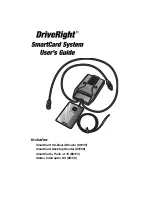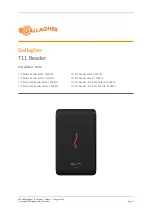
Chapter
6
Operating Instructions
CLV490 Bar Code Scanner
6-48
©
SICK AG · Division Auto Ident · Germany · All rights reserved
8009993/RA61/2007-07-20
Operation
Choosing displayed curves
¾
To check the parameterization of the autofocus function of the CLV490, activate the
A
UTOFOCUS
checkbox in the A
NALYSE
section.
We recommend that just the background without object be viewed with the function
first, and then check whether the CLV490 has correctly focused on the object after it is
brought into the foreground.
¾
To check the parameterization of the object polling function of the CLV490, activate the
O
BJEKT
RECOGNITION
checkbox in the A
NALYSE
section.
If the CLV490 detects a current object, the diagram displays an object detection marker
(rhombi).
Test: Remove the object. The CLV490 must not focuse, also not to the background.
Starting/Stopping updating
CLV-Setup polls the CLV490 once per second for the current distance profile (red) of the
scan line in order to update the display.
1.
To "freeze" the curves temporarily for viewing, click the S
TOP
button.
CLV-Setup interrupts the updating process.
2.
To continue, click the START button.
CLV-Setup continues updating.
The curves for the corrected background (blue) are static and are only polled once when
the dialog box is opened.
Zooming in on area of plot diagram
Any area of the plot diagram can be enlarged (zoomed in) by selecting it with the mouse
(hold down the left mouse button and drag the cursor to form a rectangle). Pressing the right
mouse button returns to the plot diagram at the normal output size.
6.5.7
I/O monitor in increment trigger
Function of the
auxiliary interface
. In this mode, CLV-Setup displays the conditions of the
various switching inputs/outputs of the CLV490 and any data transfer via the host interface.
This is done in a dialog box and is time-independent of the increment trigger. Increment
signals to the switching input "IN 4" of the CLV490 in the "Tracking" reading mode are
required here. The display is continuous; the monitored signals are recorded. After the
monitor is called up, the display is started by the next data output from the CLV490.
The display function in CLV490-Setup can be used for troubleshooting when starting up or
when malfunctions occur during operation, as it supplies a convenient overview of the
system condition at each moment. The function itself has no effect on the CLV490, apart
from the temporary change of the auxiliary interface operating mode.
The inputs, outputs and direction of data transfer which is to be monitored can be selected.
The display sequence of the signals in the plot diagram can be changed. Up to 15 signals
can be displayed one under the other at the same time. The contents of the data output or
data reception of the host interface is displayed separately without protocol characters in
two output fields. The configured signal selection/sequence remains until CLV-Setup is
ended so that the monitor can be called up again without needing to be reconfigured.
WW
W
.100
Y.COM.TW
WW
W
.100
Y.COM.TW
WW
W
.100
Y.COM.TW
WW
W
.100
Y.COM.TW
WW
W
.100
Y.COM.TW
WW
W
.100
Y.COM.TW
WW
W
.100
Y.COM.TW
WW
W
.100
Y.COM.TW
WW
W
.100
Y.COM.TW
WW
W
.100
Y.COM.TW
WW
W
.100
Y.COM.TW
WW
W
.100
Y.COM.TW
WW
W
.100
Y.COM.TW
WW
W
.100
Y.COM.TW
WW
W
.100
Y.COM.TW
WW
W
.100
Y.COM.TW
WW
W
.100
Y.COM.TW
WW
W
.100
Y.COM.TW
WW
W
.100
Y.COM.TW
WW
W
.100
Y.COM.TW
WW
W
.100
Y.COM.TW
WW
W
.100
Y.COM.TW
WW
W
.100
Y.COM.TW
WW
W
.100
Y.COM.TW
WW
W
.100
Y.COM.TW
WW
W
.100
Y.COM.TW
WW
W
.100
Y.COM.TW
WW
W
.100
Y.COM.TW
WW
W
.100
Y.COM.TW
WW
W
.100
Y.COM.TW
WW
W
.100
Y.COM.TW
WW
W
.100
Y.COM.TW
WW
W
.100
Y.COM.TW
WW
W
.100
Y.COM.TW
WW
W
.100
Y.COM.TW
WW
W
.100
Y.COM.TW
WW
W
.100
Y.COM.TW
WW
W
.100
Y.COM.TW
WW
W
.100
Y.COM.TW
WW
W
.100
Y.COM.TW
WW
W
.100
Y.COM.TW
WW
W
.100
Y.COM.TW
WW
W
.100
Y.COM.TW
WW
W
.100
Y.COM.TW
WW
W
.100
Y.COM.TW
WW
W
.100
Y.COM.TW
WW
W
.100
Y.COM.TW
WW
W
.100
Y.COM.TW
WW
W
.100
Y.COM.TW
WW
W
.100
Y.COM.TW
WW
W
.100
Y.COM.TW
WW
W
.100
Y.COM.TW
WW
W
.100
Y.COM.TW
WW
W
.100
Y.COM.TW
WW
W
.100
Y.COM.TW
WW
W
.100
Y.COM.TW
WW
W
.100
Y.COM.TW
WW
W
.100
Y.COM.TW
WW
W
.100
Y.COM.TW
WW
W
.100
Y.COM.TW
WW
W
.100
Y.COM.TW
WW
W
.100
Y.COM.TW
WW
W
.100
Y.COM.TW
WW
W
.100
Y.COM.TW
WW
W
.100
Y.COM.TW
WW
W
.100
Y.COM.TW
WW
W
.100
Y.COM.TW
WW
W
.100
Y.COM.TW
WW
W
.100
Y.COM.TW
WW
W
.100
Y.COM.TW
WW
W
.100
Y.COM.TW
WW
W
.100
Y.COM.TW
WW
W
.100
Y.COM.TW
WW
W
.100
Y.COM.TW
WW
W
.100
Y.COM.TW
WW
W
.100
Y.COM.TW
WW
W
.100
Y.COM.TW
WW
W
.100
Y.COM.TW
WW
W
.100
Y.COM.TW
WW
W
.100
Y.COM.TW
WW
W
.100
Y.COM.TW
WW
W
.100
Y.COM.TW
WW
W
.100
Y.COM.TW
WW
W
.100
Y.COM.TW
WW
W
.100
Y.COM.TW
WW
W
.100
Y.COM.TW
WW
W
.100
Y.COM.TW
WW
W
.100
Y.COM.TW
WW
W
.100
Y.COM.TW
WW
W
.100
Y.COM.TW
WW
W
.100
Y.COM.TW
WW
W
.100
Y.COM.TW
WW
W
.100
Y.COM.TW
WW
W
.100
Y.COM.TW
WW
W
.100
Y.COM.TW
WW
W
.100
Y.COM.TW
WW
W
.100
Y.COM.TW
WW
W
.100
Y.COM.TW
WW
W
.100
Y.COM.TW
WW
W
.100
Y.COM.TW
WW
W
.100
Y.COM.TW
WW
W
.100
Y.COM.TW
WW
W
.100
Y.COM.TW
WW
W
.100
Y.COM.TW
WW
W
.100
Y.COM.TW
WW
W
.100
Y.COM.TW
WW
W
.100
Y.COM.TW
WW
W
.100
Y.COM.TW
WW
W
.100
Y.COM.TW
WW
W
.100
Y.COM.TW
WW
W
.100
Y.COM.TW
WW
W
.100
Y.COM.TW
WW
W
.100
Y.COM.TW
WW
W
.100
Y.COM.TW
















































